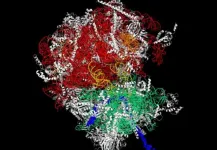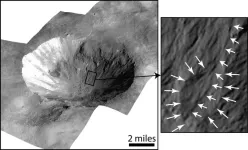(Press-News.org) Climate change is increasingly influencing fire behaviour worldwide and intensifying fire smoke, endangering public health from air pollution caused by fires. These are the results of two new climate change impact attribution studies, both published in Nature Climate Change, with involvement of the Potsdam Institute for Climate Impact Research PIK. The first study finds 15.8 percent higher global burned areas over the period 2003 to 2019 due to climate change, intensifying fire activity especially in Australia, South America, Western North America and Siberia. These increasing fire dynamics offset the decrease in burned area due to land-use changes and increasing population density. Building on this, the second study examines how climate change is linked to a global increase in deaths from fire-related air pollution. Climate change increased these deaths from 669 annually in the 1960s to over 12,500 in the 2010s.
“Our study demonstrates that when fires do occur, the influence of climate change with drier and warmer weather conditions is increasingly significant,” explains Chantelle Burton, researcher at the Met Office Hadley Centre and joint lead-author of the first study. In the paper, the researchers map the influence of climate change and socio-economic factors on global and regional ‘burned area’ from wildfires in forests, savannahs etc. Using a comprehensive ensemble of global fire-vegetation models, they show that climate change has increased the global burned area by 15.8 percent from 2003 to 2019 compared to a situation without climate change, with hotspots in Australia, South America, Western North America and Siberia - major fire-prone regions.
For the same period, they illustrate that climate change made months with above-average burned areas more likely. Yet, overall, global total burned area is decreasing as natural lands are converted for human uses, such as agriculture, which has reduced available areas for fires by about 19 percent over the same period. While these trends currently offset each other, the researchers find that the effect of climate change on fires is increasing over time, as the climate continues to warm.
Air pollution from fires poses a health risk to the population
The second study assesses the global impact of climate change on air pollution from fires and associated health risks over the past 60 years. The team of researchers finds that fire-related deaths from air pollution have risen from 46,401 annually in the 1960s to 98,748 in the 2010s. Among those, 669 annually in the 1960s to over 12,500 in the 2010s can be attributed to climate change, according to the scientists. “This indicates that climate change is increasingly posing a threat to public health, driven by more fire smoke even affecting densely populated areas," explains Chae Yeon Park, researcher at the Japanese National Institute of Advanced Industrial Science and Technology and lead author of this study.
Fire smoke contains extremely small particles. These particles are small enough to enter the respiratory system and pose significant health risks causing pulmonary and respiratory diseases. Regions like South America, Australia and Europe experienced the most significant increases in fire mortality attributed to climate change, coinciding with hotter, drier conditions caused by global warming. While decreasing humidity and rising temperatures are increasing fire risks, the researchers also observed that in some areas, such as South Asia, increasing humidity led to fewer deaths from fires that are due to climate change.
"It’s crucial to understand that the impact of smoke from fires extends beyond those living directly in the affected areas—it also significantly affects people living in cities,” concludes Christopher Reyer, PIK researcher and co-author of the study. “While cities might not face immediate fatalities from wildfires, our study confirms that smoke exposure can lead to serious public health consequences. Thus, it is vital to reduce emissions and enhance fire management strategies, to minimize the impacts of fires on ecosystems, economies, and public health across the globe."
Article 1: Chantelle Burton and Seppe Lampe, Douglas I. Kelley, Wim Thiery, Stijn Hantson, Nikos Christidis, Lukas Gudmundsson, Matthew Forrest, Eleanor Burke, Jinfeng Chang, Huilin Huang, Akihiko Ito, Sian Kou-Giesbrecht, Gitta Lasslop, Wei Li, Lars Nieradzik, Fang Li, Yang Chen, James Randerson, Christopher P.O. Reyer, Matthias Mengel (2024): Global burned area increasingly explained by climate change. Nature Climate Change. [DOI:10.1038/s41558-024-02140-w]
Weblink to the article, once published: https://doi.org/10.1038/s41558-024-02140-w
Article 2: Chae Yeon Park, Kiyoshi Takahashi, Shinichiro Fujimori, Thanapat Jansakoo, Chantelle Burton, Huilin Huang, Sian Kou-Giesbrechte, Christopher P.O. Reyer, Matthias Mengel, Eleanor Burke, Fang Li, Stijn Hantson, Junya Takakura, Dong Kun Lee, and Tomoko Hasegawa (2024): Attributing human mortality from fire PM2.5 to climate change. Nature Climate Change.
[DOI: 10.1038/s41558-024-02149-1]
Weblink to the article, once published: https://www.nature.com/articles/s41558-024-02149-1
END
New attribution studies: Increasing effects of global warming on fire dynamics and public health
2024-10-21
ELSE PRESS RELEASES FROM THIS DATE:
Strategies to help patients navigate high prescription drug costs
2024-10-21
About The Study: The current patchwork of strategies to help patients manage high prescription drug costs highlights the structural and policy challenges within the U.S. prescription drug market that impede affordable access for some patients. While these strategies provide tangible solutions for clinicians to help patients access medically appropriate but costly medications, they do not address the root causes of high drug prices.
Corresponding Author: To contact the corresponding author, Hussain S. Lalani, MD, MPH, MSc, email hlalani@bwh.harvard.edu.
To access the embargoed study: Visit our For The Media website at this ...
City of Hope to present innovative research and treatment options for cancer patients at the 21st International Conference of the Society for Integrative Oncology
2024-10-21
LOS ANGELES — Researchers from City of Hope®, one of the largest and most advanced cancer research and treatment organizations in the United States, ranked among the nation’s top 5 cancer centers by U.S. News & World Report and a national leader in providing cancer patients with best-in-class, integrated supportive care programs, will present new data on integrative oncology research and clinical trials at the 21st International Conference of the Society for Integrative Oncology taking place Oct. 25 to 27.
Integrative oncology is a patient-centered ...
Amsterdam UMC-led researchers develop way to predict epilepsy after rare stroke
2024-10-21
Researchers from 15 countries, led by Amsterdam UMC, have developed a way to predict which patients are at risk of epilepsy after a cerebral venous sinus thrombosis (CVT). CVT is a type of stroke that typically affects women between the ages of 20 and 50. The prediction model is now available worldwide free of charge and research it is based on is published today in JAMA Neurology.
"We hope that as many physicians as possible will use this score to better treat and educate CVT patients across the world," says lead researcher and neurologist at Amsterdam UMC, Jonathan Coutinho.
CVT occurs when a clot blocks the veins ...
National trends in infant mortality in the US after Dobbs
2024-10-21
About The Study: Infant mortality was higher than expected, overall and among those with congenital anomalies, for several months after the Dobbs decision in the U.S. No post-Dobbs months (i.e., no months after June 2022) showed lower than expected infant mortality. These findings are consistent with the increase in infant mortality found in Texas following the state’s abortion ban.
Corresponding Author: To contact the corresponding author, Parvati Singh, PhD, email singh.1704@osu.edu.
To access the embargoed study: Visit our For The Media website at this link https://media.jamanetwork.com/
(doi:10.1001/jamapediatrics.2024.4276)
Editor’s ...
Stalking ribosomes: How cancer cells pull poker faces
2024-10-21
STALKING RIBOSOMES: HOW CANCER CELLS PULL POKER FACES
The protein factories of our cells are much more diverse than we thought they were. Scientists from the Netherlands Cancer Institute have now shown that cancer cells can use these so-called ribosomes to boost their invisibility cloak, helping them hide from the immune system. The team publishes their findings in Cell today. “These findings make us change how we think about ribosomes.”
Our immune system is constantly monitoring our body. In order to survive, cancer cells need to evade this ...
At-home brain stimulation for depression is safe and effective, according to research from UTHealth Houston, King’s College London, and University of East London
2024-10-21
A device that delivers direct stimulation to the brain was found to be a safe and effective means of treating depression at home, according to a new study by researchers at UTHealth Houston; the Institute of Psychiatry, Psychology & Neuroscience at King’s College London; and the University of East London.
The research was published in Nature Medicine on Oct. 21, 2024.
Transcranial direct current stimulation (tDCS) is a form of noninvasive brain stimulation that applies a weak, direct current of between 0.5 to 2 milliampere to the scalp via two electrodes. It is already commonly used in clinics to treat conditions such as psychosis ...
A 37% drop in overdose deaths from drugs mixed with opioids – fentanyl included
2024-10-21
COLUMBUS, Ohio – Expanded treatment options, increased naloxone distribution and targeted education campaigns likely led to a 37% reduction in overdose deaths from opioids combined with stimulant drugs other than cocaine, according to the results of a large federally funded study.
The finding came from a planned study of secondary outcomes of the HEALing (Helping to End Addiction Long-Term) Communities Study (HCS), which tested an intervention encompassing data-driven adoption of evidence-based practices for reducing overdose deaths in Kentucky, Massachusetts, New York and Ohio.
Death rates from specific combinations of ...
Research spotlight: Investigating strategies to help clinicians and patients navigate prescription costs
2024-10-21
Hussain S. Lalani, MD, MPH, MSc, of the Division of Pharmacoepidemiology and Pharmacoeconomics at Brigham and Women’s Hospital, is the lead author of a paper published in JAMA, “Strategies to Help Patients Navigate High Prescription Drug Costs.”
How would you summarize your study for a lay audience?
Prescription drugs can be expensive for patients, and many clinicians do not know how to respond when costs are too high. We reviewed the benefits and limitations of seven strategies that clinicians can use to help their patients navigate high-prescription drugs. These include co-payment cards, patient assistance ...
Betelgeuse Betelgeuse? Bright star Betelgeuse likely has a ‘Betelbuddy’ stellar companion
2024-10-21
The 10th-brightest star in the night sky, Betelgeuse, may not be on the brink of exploding as a supernova, according to a new study of the star’s brightening and dimming. Instead, recent research shows that the observed pulsing of the starlight is probably caused by an unseen companion star orbiting Betelgeuse.
Formally named Alpha Ori B, the “Betelbuddy” (as astrophysicist Jared Goldberg calls it) acts like a snowplow as it orbits Betelgeuse, pushing light-blocking dust out of the way and temporarily making Betelgeuse seem brighter. Goldberg and his colleagues present their simulations of this process in ...
SwRI and JPL co-led study offers insights into mysterious features on airless worlds
2024-10-21
SAN ANTONIO — October 21, 2024—A Southwest Research Institute researcher collaborated with a team at NASA’s Jet Propulsion Laboratory to attempt to explain the presence of mysterious flow features that exist on the surfaces of airless celestial bodies, such as the asteroids Vesta and Ceres, explored recently by the NASA Dawn mission, or Jupiter’s moon Europa, which will soon be explored in detail by the NASA Europa Clipper mission that includes SwRI’s involvement.
In a new paper published in The Planetary Science Journal, its lead author, SwRI’s Dr. Michael J. Poston, and a team of researchers outline how post-impact conditions, ...



